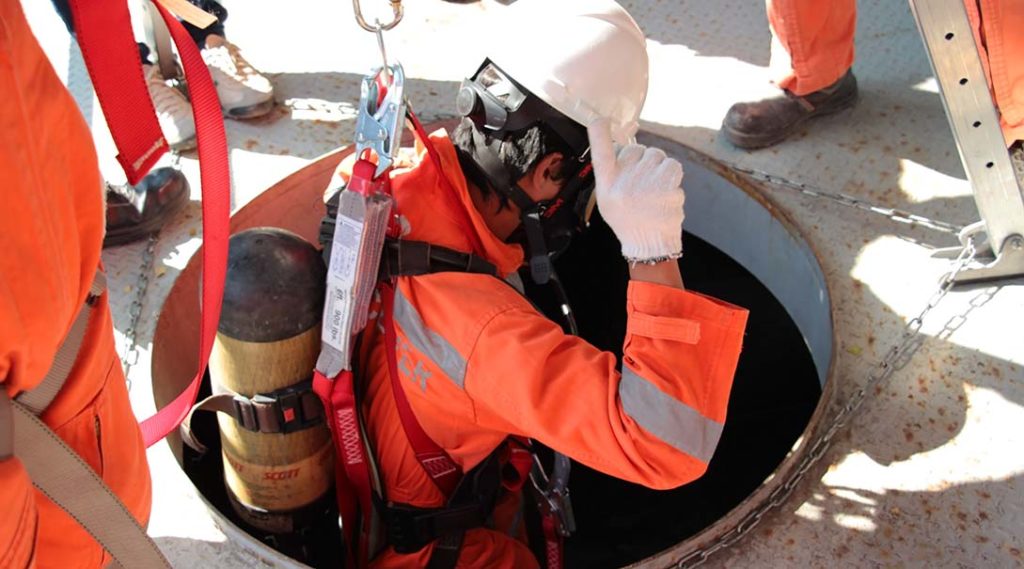Every year, occupational health and safety risks negatively impact workers in the utility industry in Florida and around the U.S. They can also cause disruptions in power generation when not managed appropriately, affecting the operations of power plants and leaving customers literally in the dark.
With a clear understanding of occupational health and safety risks, as well as strategies and programs in place to address them, employees can work more safely, and companies can reduce risks and hazards that endanger their people and their profits.
Top Utility Industry Workplace Risks and Hazards
Here are six common workplace risks and hazards in the utility industry:
1. Electrocution
Electrocution is an occupational health and safety risk that employees in multiple types of power industry jobs can be vulnerable to during the workday. Without the proper training, policies, and procedures, the consequences can be devastating. Power plant employees and other utility workers could be at risk when contacting switchgear components, electrical conductors, energized pipes, lines, and other common components and equipment they come into contact with daily.
2. Falls
Due to the nature of the work, falls are another common workplace hazard in the utility industry. Working from tall heights can be very dangerous without the proper precautions and equipment. According to a report published in 2000 by the U.S. Department of Health and Human Services (DHHS) and National Institute for Occupational Safety and Health (NIOSH), falls from elevations were the fourth leading cause of occupational fatalities from 1980 through 1994, with a total of 8,102 deaths due to falls. With the implementation of safety regulations and policies required by OSHA and ongoing training for employees, the risks of falls can be significantly decreased.
3. Fires and Explosions
Power plants must follow strict procedures to avoid fires and explosions as these risks pose the ultimate danger to power generation employees and can close businesses forever. Fire and explosion risk can be present during boiler startup, operation, and shutdown, among other plant areas and operations. Coal dust accumulation and pipes under high working pressure can be additional causes of fires and explosions. OSHA has general literature on fire and explosion safety, including topics such as compressed gas and equipment, emergency preparedness and response, hazard communication, pressure vessels, process safety management, and welding, cutting, and brazing. Getting an on-site evaluation to identify fire and explosion risk is highly recommended.
4. Sprains, Strains, and Fractures
Day-to-day work in the utility industry requires a lot of strength and often involves repetitive movements. Employees may use awkward postures and frequently must deal with vibration and poorly designed tools. Sprains, strains, and fractures can put employees out of work for days, weeks, or even months when they get hurt. All power plants and companies in the utility industry should place a focus on ergonomics to protect workers. It is also a good idea to encourage early reporting of musculoskeletal disorders (MSDs) to help to prevent or reduce the progression of symptoms, the development of serious injuries, and lost-time claims. With the right training, processes, and programs incorporated in daily operations, the risks of these injuries can be reduced.
5. Confined Spaces
The deaths of workers in confined spaces are a recurring tragedy. It is another common occupational health & safety risk that can be extremely dangerous to power generation professionals. Confined spaces are not only risky because of their construction but also because of their potential to contain a serious, atmospheric hazard. They are not necessarily designed for humans but can fit humans and typically have limited or restricted means for entry or exit and are not designed for continuous occupancy.
6. Environmental Stress
Environmental stress is a workplace hazard that employees in the power industry know well. Hazardous heat exposure can occur indoors or outdoors. Heat illness has risk factors, including hot environmental conditions, heavy physical activity, lack of acclimatization, and wearing clothing that holds in heat. All power plants and other utility companies should have plans to prevent heat illness and help employers and workers recognize risk factors and develop effective strategies to control and reduce heat risk.
These six common workplace risks and hazards cause harm to many workers and interrupt plant operations in Florida and across the Southeast every year. Fortunately, much work can be done to reduce risks and hazards due to electrocution, falls, fires and explosions, sprains, strains, and fractures, confined spaces, and environmental risks to protect your employees while keeping your plant operations running efficiently and effectively.
Reducing Risks and Hazards
Salvation Safety specializes in occupational health & safety training and compliance for the utility and power generation sector. We have an experienced, highly skilled team of professionals that know how to recognize occupational health & safety risks and develop customized solutions to reduce risks and hazards in power plants.
Our trusted team includes Certified Site Safety Managers, Site Safety Coordinators, Compliance Auditors, Safety Instructors, as well as Confined Space Rescue Responders and Confined Space Rescue Attendants.
We provide professional, comprehensive evaluations to identify site-specific occupational health & safety risks and deliver targeted solutions to reduce risks and hazards to your employees and your business. We take into consideration facility processes, operations, and resources, personnel performance characteristics, OSHA requirements, and recognized health and safety standards.
As industry experts, we understand the complex occupational health and safety needs of our clients. Our services include but are not limited to Job Safety Analysis (JSA), Health & Safety Compliance Assessments, Industrial Hygiene Services, OSHA Compliance, and On-site Safety Management. We also provide comprehensive training, including General Industry Safety, Fall Protection, First Aid & CPR/ AED, and Permit-Required Confined Space Entry courses.
Contact us today to learn more about our on-site safety services. We can help you reduce your occupational health & safety risks to protect the health of your employees and your business.





